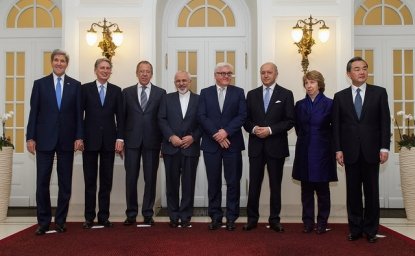So what went wrong? How come the champagne corks aren’t popping in Vienna? After all the hype, drama, and suspense, why is it that all we have to show is a close-but-no-cigar seven-month extension?
All is not lost. With a deadline pushed until next summer, the negotiations are already set to resume in December. And though critics of the deal will shout from the rooftops that this extension will only give Iran more leverage, it’s still possible that a way could be found to reach a comprehensive agreement.
But why wasn’t it possible by Nov. 24? As John Kerry suggested today, more time will not make matters easier. Sure, the gaps were wide, the suspicions deep, the politics constraining. All of this was known in advance. It’s not as if the U.S. negotiators realized at the eleventh hour that a comprehensive deal was a long shot.
But was this a doomed enterprise from the start? Or was it just that more time was required to make a deal? Or was there something wrong with the structure of the trade-off: Iranian concessions on substance upfront for gradual removal of sanctions?
I’ve been involved in a lot of tough negotiations -- most of them failures -- and I’ve seen what happens when negotiators get too close and attached to their deal. Indeed, in every negotiation, those at the table enter with a set of assumptions about the other side that reality soon tests, a mindset of analytical realities that are either borne out or not.
Here are the four faulty (or yet to be realized) assumptions that drove the talented and committed U.S. negotiators to believe that a comprehensive agreement was possible.
1. Rouhani and Zarif have the power to cut a bargain.
The president and foreign minister of Iran may be moderates, but they are not free agents and don’t work for the United States. Iran is an authoritarian state -- and yet one with a real political life, complete with tense divisions at the top, bottom, and center. But amid all the tea leaf reading and studying the entrails of goats, one thing is stunningly obvious even to the interminably obtuse: At the apex of this pyramid sits an aging theocracy at whose center is Supreme Leader Ayatollah Ali Khamenei -- the final arbiter on all matters of state.
Rouhani came to office promising “prudence and hope,” and even penned an op-ed in the Washington Post entitled “Time to Engage.” But these overtures all came with the blessing of the establishment: Khamenei gave the president the necessary breathing room to secure a comprehensive accord. For instance, in September 2013, as Rouhani was preparing to make his maiden voyage to New York, the supreme leader called for “heroic leniency” on the nuclear file, stressing that he was not opposed to “correct diplomacy.”
It has been Khamenei calling the shots throughout this entire process -- setting clear red lines that were never to be crossed. Zarif said as much this September, during an appearance at the Council on Foreign Relations: “Of course, we have a plurality of opinion in Iran and people have different opinions, but we have a single foreign policy, and that is why foreign policy, according to [the] Iranian constitution, the general framework of foreign policy is set by the leader so that we will not have domestic squabbling over foreign policy.”
If past is prologue, Khamenei and his conservative allies aren’t afraid to rein in moderate politicians who might wander astray. We’ve seen this before during the reformist presidency of Mohammad Khatami, who was dubbed “Ayatollah Gorbachev” after winning the election of 1997. During his tenure, a fifth column was out for blood and thwarted his every move, leading Khatami to quip that his government “survived on average one national crisis every nine days.”
For instance, after Khatami called for a “dialogue among civilizations” with the West in a groundbreaking CNN interview early in his first term, the Supreme Leader roundly rejected such a détente. “Talks with the United States have no benefit for us and are harmful to us,” said Khamenei. “We don’t need any talks or relations with the United States. The regime of the United States is the enemy of the Islamic Republic.”
In the end, it was Khatami -- not Khamenei or his disciples -- who paid a high price for such adventurism: During his term, reformist newspapers including Jame’e, Salam, and Neshat were banned; one of Khatami’s closest political advisors was gunned down; and 24 Iranian Revolutionary Guard Corps commanders issued a public letter accusing him of leading Iran into “anarchy.”
Let’s also remember that it was Rouhani who resigned as Iran’s chief nuclear negotiator after clashes with the newly elected hard-line President Mahmoud Ahmadinejad back in 2005; reports indicate that the Supreme Leader actively supported Ahmadinejad’s candidacy. With reformists and moderates out of fashion, Rouhani quickly lost his mandate.
So Rouhani and Zarif -- just like their predecessors -- are on a retractable leash.
2. Iran needs a deal.
Sure, but how badly? In any negotiation, cutting a deal requires not just urgency but that both sides have clocks that are in sync or closely coordinated. The American sense of time is measured in four- and eight-year increments, driven by elections and politics; the Iranian clock is much more open-ended. Part of that flexibility has to do with the fact that however pressed those who want a deal may feel, Iran has demonstrated remarkable capacity to resist economic pressure and to adjust to the imposition of sanctions and declining oil prices. The sanctions may have brought the mullahs to the table, but that doesn’t mean that they can force a deal. Tehran has been nimble in finding loopholes to lessen the bite of sanctions, and Khamenei’s “economy of resistance” is more than just a revolutionary talking point.
The New York Times in August reported that the Islamic Republic found a way around the sanctions in exporting petroleum products to China and other Asian countries. According to “Iranian customs data, the country in recent months has exported 525,000 barrels a day of the ultralight oil, known as condensates, over two times more than it did a year ago. In the last three months, the sales have generated as much as $1.5 billion in extra trade -- a rate of about $6 billion a year -- based on Iranian trade figures and market prices.” Not bad for a country under sanction. And later that month, Tehran and Moscow also inked a framework for a $20 billion oil-for-goods deal.
There are new indications that Iran’s economy is rebounding -- however slightly. According to CNBC, in the second quarter of 2014, “Iran’s GDP was in the plus column for the first time in 2½ years, rising 2.5 percent.”
3. Interests are more important than pride.
Maybe. But honor and dignity are hard to bargain with. The supreme leader has consistently coupled the nuclear file with the Islamic Republic’s perennial quest for dignity. And it’s personal for Khamenei.
An internal IAEA document that was prepared in 2009 detailed an April 1984 high-level meeting at the presidential palace in Tehran in which Khamenei -- then president of Iran -- championed a decision by then-Supreme Leader Ayatollah Ruhollah Khomeini to launch a nuclear weapons program. According to the account, Khamenei said that “this was the only way to secure the very essence of the Islamic Revolution from the schemes of its enemies, especially the United States and Israel, and to prepare it for the emergence of Imam Mehdi.” The former president further declared “that a nuclear arsenal would serve Iran as a deterrent in the hands of God’s soldiers.”
Fast-forward to 2014 and, after a decade of failed nuclear talks and even a fatwa against nuclear weapons, Khamenei is still publically toeing the same line -- keyed now toward maintaining a strategic nuclear hedge under the auspices of a robust “civil” nuclear energy program. In May, he described the stakes: “Logic and reason command that for Iran, in order to pass through a region full of pirates, needs to arm itself and must have the capability to defend itself.… Today’s world is full of thieves and plunderers of human honor, dignity, and morality who are equipped with knowledge, wealth, and power, and under the pretense of humanity easily commit crimes and betray human ideals and start wars in different parts of the world.”
The primacy of the nuclear file also has trickled down to the Iranian street. When Gallup asked ordinary citizens whether it was worth continuing to develop the Islamic Republic’s nuclear power program back in early 2013, almost two-thirds -- or 63 percent -- said yes.
This narrative explains why Tehran has chosen to suffer under the punishing weight of economic sanctions. According to an estimate by the Carnegie Endowment in 2013, the mullahs' nuclear program has cost the country more than $100 billion in lost oil revenue and foreign investment alone. To put that in perspective: Before the most recent round of oil-export restrictions in 2012, the Congressional Research Service estimated that oil revenue “generated about 20% of Iran’s GDP, about 80% of its foreign exchange earnings, and about 50% of its government revenue.” Those figures have surely made a dent in the economy, but not in the nuclear ambition to attain an industrial-size uranium enrichment capacity.
Thus far, the odyssey for pride, honor, and dignity has clearly trumped national interests in this equation.
4. The Rolling Stones are always right.
Not this time. Sometimes you really will hold out for what you want, not just what you need.
U.S. negotiators were hoping to find that elusive middle ground on which they might construct the kind of balance of interests required for a sustainable deal. It may well be that the constraints of domestic politics -- and particularly now with a Republican-controlled Congress -- make it nearly impossible to close an agreement. But there may well be something even more fundamental at work: a strategic disconnect.
We can’t end Iran’s nuclear capacity, so we are working to constrain it through buying time. Iran is trying to preserve as much of that capacity as possible while easing and eliminating economic pressure. And Iran is also playing with and for time. There’s really no end state, either on the nuclear issue or sanctions relief. And thus any comprehensive agreement is, by definition, interim at best. That just doesn’t add up in today’s highly charged and suspicion-laden political environment, no matter how moderate and well-intentioned the negotiators themselves may be.
The fact is that Iran knows what it wants: to preserve as much of its nuclear weapons capacity as possible and free itself from as much of the sanctions regime as it can. The mullahs see Iran’s status as a nuclear weapons state as a hedge against regime change and as consistent with its regional status as a great power. That is what it still wants. And that’s why it isn’t prepared -- yet -- to settle just for what it needs to do a deal. Ditto for America. And it’s hard to believe that another six months is going to somehow fix that problem.
The opinions expressed here are solely those of the author.
This article was originally published on ForeignPolicy.com.






